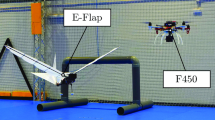Abstract
This paper addresses the problem of segmenting perception in physical robots into meaningful events along time. In structured environments this problem can be approached using domain-specific techniques, but in the general case, as when facing unknown environments, this becomes a non-trivial problem. We propose a dynamical systems approach to this problem, consisting of simultaneously learning a model of the robot’s interaction with the environment (robot and world seen as a single, coupled dynamical system), and deriving predictions about its short-term evolution. Event boundaries are detected once synchronization is lost, according to a simple statistical test. An experimental proof of concept of the proposed framework is presented, simulating a simple active perception task of a robot following a ball. The results reported here corroborate the approach, in the sense that the event boundaries are correctly detected.
Similar content being viewed by others
References
Shihua Chen and Jinhu Lü. Parameters identification and synchronization of chaotic systems based upon adaptive control. Physics Letters A, 299:353–358, 2002.
D. DeMenthon. Spatio-temporal segmentation of video by hierarchical mean shift analysis. Language, 2, 2002.
Daniel M. Dubois. Mathematical foundations of discrete and functional systems with strong and weak anticipations. In Anticipatory Behavior in Adaptive Learning Systems, Lecture Notes in Computer Science, page 107–125. Springer, 2003.
V. Guralnik and J. Srivastava. Event detection from time series data. In Proceedings of the fifth ACM SIGKDD international conference on Knowledge discovery and data mining, page 33–42. ACM, 1999.
Mitsuo Kawato. Internal models for motor control and trajectory planning. Current Opinion in Neurobiology, 9(6):718–727, December 1999.
Daehwan Kim, Jinyoung Song, and Daijin Kim. Simultaneous gesture segmentation and recognition based on forward spotting accumulative hmms. Pattern Recognition, 40(11):3012–3026, November 2007.
Christopher A. Kurby and Jeffrey M. Zacks. Segmentation in the perception and memory of events. Trends in Cognitive Sciences, 12(2):72–79, February 2008.
R.C. Miall, D. J. Weir, D. M. Wolpert, and J. F. Stein. Is the cerebellum a smith predictor? Journal of Motor Behavior, 25(3):203–216, 1993.
Bruno Nery and Rodrigo Ventura. Online event segmentation in active perception using adaptive strong anticipation. In Alexei V. Samsonovich, George Mason University, Kamilla R. Jóhannsdóttir, Antonio Chella, and Ben Goertzel, editors, Biologically Inspired Cognitive Architectures 2010: Proceedings of the First Annual Meeting of the Bica Society (BICA-2010), volume 221 of Frontiers in Artificial Intelligence and Applications, page 86–91. IOS Press, 2010.
Louis M. Pecora, Thomas L. Carroll, Gregg A. Johnson, and Douglas J. Mar. Fundamentals of synchronization in chaotic systems, concepts, and applications. Chaos, 7(4):520–543, 1997.
Erich Prem, Erik Hörtnagl, and Georg Dorffner. Growing event memories for autonomous robots. In Proceedings of the Workshop On Growing Artifacts that Live: Basic Principles and Future Trends, 2002.
Marco Ramoni, Paola Sebastiani, and Paul Cohen. Unsupervised clustering of robot activities: a bayesian approach. In Proceedings of the fourth international conference on Autonomous agents (AGENTS00), page 134–135, 2000.
Wolfram Schultz and Anthony Dickinson. Neuronal coding of prediction errors. Annual Review of Neuroscience, 23:473–500, 2000.
N. Stepp and M.T. Turvey On strong anticipation. Cognitive Systems Research, 11:148–164, 2010.
Henning U. Voss. Anticipating chaotic synchronization. Physical review E, 61(5):5115–5119, 2000.
Henning U. Voss. Dynamic long-term anticipation of chaotic states. Physical Review Letters, 87(1):14102, July 2001.
J.Y.A. Wang and E.H. Adelson. Spatio-temporal segmentation of video data. In SPIE Proceedings Image and Video Processing II, volume 2182, page 120–131, 1994.
Daniel M. Wolpert, R. Chris Miallb, and Mitsuo Kawato. Internal models in the cerebellum. Trends in Cognitive Sciences, 2(9):338–347, 1998.
Jeffrey M. Zacks, Nicole K. Speer, Khena M. Swallow, Todd S. Braver, and Jeremy R. Reynolds. Event perception: A mind-brain perspective. Psychological Bulletin, 133(2):273–293, 2007.
Author information
Authors and Affiliations
Corresponding author
Additional information
This work was supported by the FCT (ISR/IST plurianual funding) through the PIDDAC Program funds. Partially funded with grant SFRH/BD/60853/2009, from Fundação para a Ciência e a Tecnologia.
About this article
Cite this article
Nery, B., Ventura, R. A dynamical systems approach to online event segmentation in cognitive robotics. Paladyn 2, 18–24 (2011). https://doi.org/10.2478/s13230-011-0011-y
Received:
Accepted:
Published:
Issue Date:
DOI: https://doi.org/10.2478/s13230-011-0011-y




